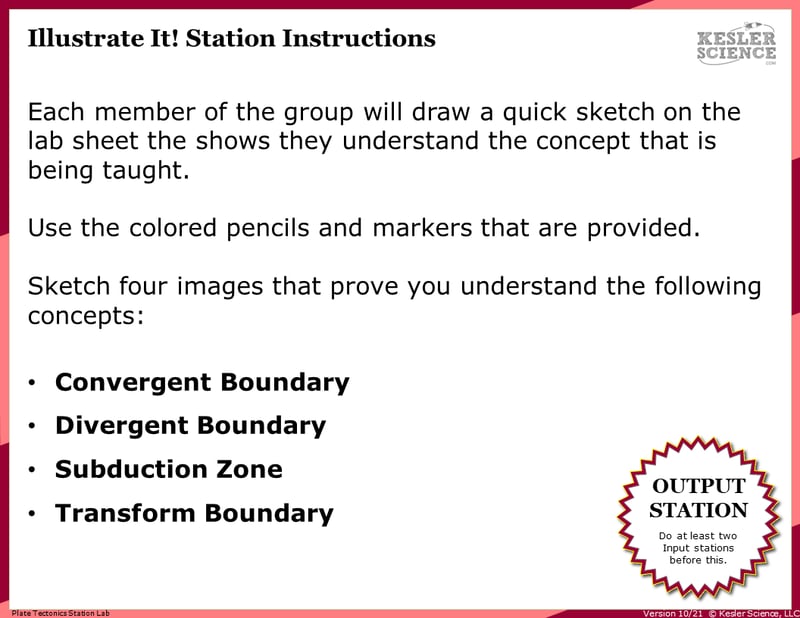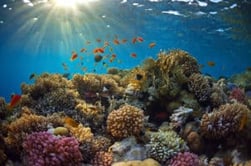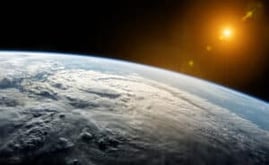Plate Boundaries Lesson Plan – A Complete Science Lesson Using the 5E Method of Instruction
By the end of this lesson about plate tectonics and plate boundaries, students will be able to relate plate tectonics to the formation of crustal features. Each of our lessons is designed using the 5E method of instruction to ensure maximum comprehension by the students. This well-thought out unit does the heavy lifting, giving teachers easy-to-implement, highly engaging lesson plans.
This blog will walk you through each of the steps and activities from the Plate Boundaries 5E Lesson Plan.
ENGAGEMENT
Objective Introduction
At the beginning of the lesson, the class will do a Think-Pair-Share to discuss the objective.
Class Activity
- Put three vocabulary words on the board without defining them (converging, diverging, and transform)
- Activate prior knowledge by asking the students what they think these words mean.
Student Activity
- Give each pair of students a square (half) of a graham cracker, a plate and some frosting. You should try this prior to the students, so you can better determine the amount of frosting.
- Have the students fold a sheet of notebook paper into three columns.
- Have the students break their graham cracker into two pieces. They don’t have to be the same sizes.
- Tell them the graham crackers represent the Earth’s crust, which is broken into large pieces called plates. The frosting represents the viscous asthenosphere. Show provided PowerPoint slide.
- Put the two pieces of graham cracker on the top of a layer of frosting about two inches apart. Have them slowly push the two layers toward each other and observe what happens.
- In one column on their paper have the students draw what they see using arrows to indicate the movement of the plates. Have them describe in words what is happening. (Hopefully, they come up with colliding, coming together, moving towards each other or something similar.) Label this column with the word converging.
- Now put the graham cracker pieces next to each other and move them apart. In another column on their paper have the students draw what they see using words to indicate the movement of the plates. Have them describe in words what is happening. (Hopefully, they come up with separating, moving apart, dividing or something similar.) Label this column with the word diverging.
- Thirdly, put the graham cracker pieces next to each other and move one toward the top of the plate and the other toward the bottom of the plate. In one column on their paper have the students draw what they see using arrows to indicate movement of the plates. Have them describe in words what is happening. (Hopefully, they come up with sliding past each other or something similar.) Label this column with the word transform.
- Tell students if they know and understand these three words they will have success studying “Plate Tectonics.”
- Let students each eat their graham cracker if approved by the school.

The teacher will help to clear any misconceptions about plate boundaries. A major misconception is that students may only think plates diverge and not understand they can both converge and slip past each other as well.
Estimated Class Time for the Engagement: 20-30 minutes
EXPLORATION
This student-centered station lab is set up so students can begin to explore plate boundaries. With nine stations in total, you can introduce plate tectonics and boundaries to your middle school students in a variety of ways! Four of these stations are considered input stations where students will learn new information about plate tectonics and boundaries, and four of the stations are output stations where students will be demonstrating their mastery of the lesson's material. A bonus station offers challenges for your early finishers and independent learners. You can read more about how I set up the station labs here.
Watch It!
At this station, students will be watching a short video explaining plate tectonics. Students will then answer questions related to the video and record their answers on their lab station sheet. For example: What causes the tectonic plates to move? How did the creator of this video explain why some plates are moving faster than others? What are the three main types of plate boundaries?
Read It!
This station will provide students with a one-page reading about plate boundaries. Students will read about the three different types of plate boundaries and the unique geological features that they create. There are four follow-up questions that the students will answer to demonstrate their comprehension of the reading material.
Explore It!
Students will be working in pairs to better understand the three types of plate boundaries. Students will be using a number of manipulatives that help demonstrate the types of geological features each plate boundary creates. Students will record their observations on their lab sheet.
Research It!
The research station will allow students to use an interactive online website to look at different layers of Earth. Students will be then instructed to complete a few tasks and record answers on their lab sheets in order to better understand what they're looking at and how to interpret that information.
Organize It!
The Organize It station allows your students to organize key terms and descriptions to label what happens at plate boundaries. Once students have completed their organization, the teacher will come and check their understanding.
Illustrate It!
Your visual students will love this station. Students will draw four different types of plate boundaries. Students will use arrows to indicate the movement of each plate.

Write It!
Students who can answer open-ended questions about the lab truly understand the concepts that are being taught. At this station the students will be answering three task cards: Compare convergent plate boundaries that have the same density to convergent plate boundaries with different densities. What causes the tectonic plates to move? Describe what geological features are created at convergent, divergent, and transform plate boundaries.
Assess It!
The Assess It station is where students will go to prove mastery over the concepts they learned in the lab. The questions are set up in a standardized format with multiple choice answers. Some questions include: What geological feature can be created by a divergent boundary? What is the difference between convergent and divergent plate boundaries? The diagram below would indicate the formation of what geological feature? What geological feature can be created by a transform boundary?
Challenge It! - Bonus Station
Early finishers and advanced students will love the extension activities in this station. Four activity choices offer them ways to expand their learning through mini-games and mini-projects.
Estimated Class Time for the Exploration: One or two 45-minute class periods
EXPLANATION
The explanation activities will become much more engaging for your class once they’ve completed the exploration station lab. During the explanation piece of the lesson, the teacher will be clearing up any misconceptions their students may have about plate tectonics and boundaries with a variety of materials. These materials include on-level and modified versions of the interactive presentation (may be used individually or projected), anchor charts, and paper or digital interactive notebook activities. If you have students that need modified notes, the 5E lessons come equipped to help give every student access to the lesson.
Interactive notebook samples: Above-left is a digital INB activity slide; above-right is an example of the paper INB activities.
The students will also be interacting with their journals using INB templates for plate boundaries. Each INB activity is designed to help students compartmentalize information for a greater understanding of the concept. The plate boundaries INB templates allow students to focus their notes on understanding the three different types of plate boundaries and the location and names of the major tectonic plates.
Estimated Class Time for the Exploration: Two or three 45-minute class periods
ELABORATION
The elaboration section of the 5E method of instruction gives students choices that allow them to prove they’ve mastered the concepts behind the lesson. When students are given a choice, they’re much more enthusiastic and invested in the project than they are when their teachers choose their projects for them. There are a total of nine choices to demonstrate understanding of plate boundaries and tectonics. A separate set of choices that offer more teacher support are also available for students that need them. Rubrics guide students to doing their best work and assist in grading.

Estimated Class Time for the Elaboration: Two or three 45-minute class periods (can also be used as an at-home project)
EVALUATION
The final piece of the 5E model is to evaluate your students' comprehension. Included in every 5E lesson is a homework assignment, assessment, and modified assessment. Research has shown that homework needs to be meaningful and applicable to real-world activities in order to be effective. When possible, I like to give open-ended assessments to truly gauge the student’s comprehension.
Estimated Class Time for the Elaboration: One 45-minute class period
DOWNLOAD THE FULL LESSON NOW
Download Over $100 in FREE Resources
For Middle School Science
Simply create a login below and gain immediate access to a selection of our Kesler Science product line worth $100 - for FREE. There's a full version of every product type! You'll also join tens of thousands of middle school science teachers who receive timely tips and strategies straight to their inbox.







